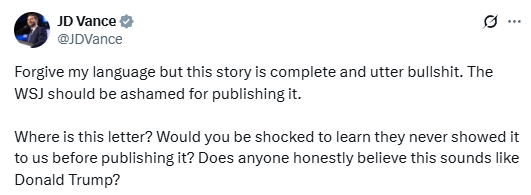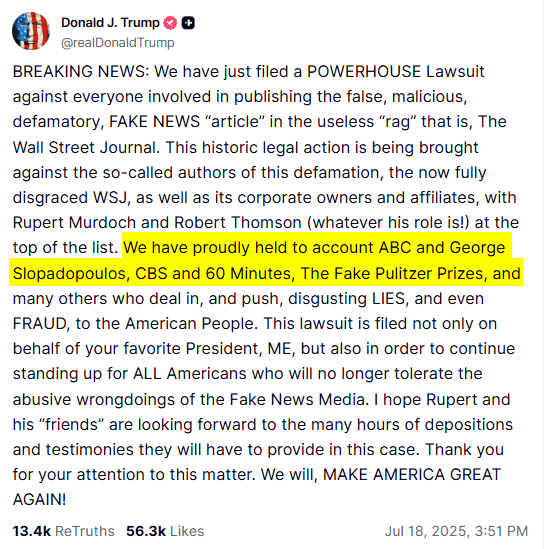from the slapp-slapp-slapp-slapp dept
We’ve seen some pretty ridiculous lawsuits here at Techdirt, but the one that Donald Trump filed on Friday against Rupert Murdoch and the Wall Street Journal over the article about the birthday card he was alleged to have given Epstein is so legally incompetent that it reads like a masterclass in how not to file a defamation claim.
The complaint is such a train wreck of basic legal errors and factual misrepresentations that it can only be understood as a SLAPP suit designed to harass the WSJ and force them to reveal sources. The legal malpractice on display would be almost comical if it weren’t so transparent in its authoritarian intent.
Trump is using a Miami law firm that appears to specialize in franchise law—which might explain the amateurish quality of this defamation complaint. When you can’t get competent media lawyers, apparently you make do with whoever will take your money.
Let’s start with what the WSJ actually reported, because the lawyers filing this suit seem to have struggled with basic reading comprehension. It claims that Trump gave Epstein a card for his 50th Birthday that, well, here’s how they describe it:
The letter bearing Trump’s name, which was reviewed by the Journal, is bawdy—like others in the album. It contains several lines of typewritten text framed by the outline of a naked woman, which appears to be hand-drawn with a heavy marker. A pair of small arcs denotes the woman’s breasts, and the future president’s signature is a squiggly “Donald” below her waist, mimicking pubic hair.
The letter concludes: “Happy Birthday — and may every day be another wonderful secret.”
The Journal also includes the type written faux dialogue between Trump and Epstein that was apparently included, which is so bizarre I’m not even going to bother repeating it here.
Here’s where the legal incompetence begins. Trump’s defenders, led by JD Vance, immediately seized on the fact that the WSJ didn’t publish a photo of the letter as somehow “proof” it doesn’t exist:

This reveals a fundamental misunderstanding of how journalism works. Major publications don’t publish stories like this without solid sourcing—the WSJ’s legal team wouldn’t allow it. More importantly, there are often very good reasons for media organizations not to reveal images of documents that have been leaked to them. Just ask Reality Winner. And, of course, I’m sure the Trump regime would love to know who leaked this document, so seeing an image might help reveal that information.
But that doesn’t make it a good legal argument. Unless you’re just trying to flush out the leaker.
So it’s notable that the lawyers decide to lead with that as their key piece of “evidence” that the story is fabricated—a strategy that’s likely to backfire spectacularly when the WSJ produces the letter in discovery (or before).
On the one hand, Defendants Safdar and Palazzolo falsely pass off as fact that President Trump, in 2003, wrote, drew, and signed this letter. And on the other hand, Defendants Safdar and Palazzolo failed to attach the letter, failed to attach the alleged drawing, failed to show proof that President Trump authored or signed any such letter, and failed to explain how this purported letter was obtained. The reason for those failures is because no authentic letter or drawing exists. Defendants concocted this story to malign President Trump’s character and integrity and deceptively portray him in a false light.
That’s a bold claim. It seems like quite the gambit to open with a claim that the letter doesn’t even exist, when it seems quite likely that this argument will come back to haunt them.
Also, the lawyers can’t even accurately describe what the WSJ reported. The complaint claims the article states that “President Trump, in 2003, wrote, drew, and signed this letter.” But that’s not what the WSJ said. The article carefully states the letter bore Trump’s name and signature, and that the drawing “appears to be hand-drawn” without attributing the drawing to Trump.
This isn’t just sloppy—it’s the kind of basic factual error that suggests the lawyers either didn’t carefully read the article they’re suing over, or are deliberately misrepresenting it.
The complaint also has a weird argument about how the WSJ published this as an “exclusive” but then… disseminated it widely. As one does. With news. I don’t know why this paragraph is in here, other than to make it clear that the lawyer who wrote this is unfamiliar with how journalism works:
The Article was published in The Wall Street Journal as an exclusive.1 However, since publication, Defendants have widely disseminated it to hundreds of millions of people worldwide.
They also double down on their claim that it’s impossible that this letter exists, which seems like a kind of lawsuit claim preceding an unfortunate event for them.
Tellingly, the Article does not explain whether Defendants have obtained a copy of the letter, have seen it, have had it described to them, or any other circumstances that would otherwise lend credibility to the Article. That is because the supposed letter is a fake and the Defendants knew it when they chose to deliberately defame President Trump.
But the most egregious nonsense comes in how they identify the allegedly defamatory statements.
In a defamation lawsuit, you have to state which statements made by the defendant were “false statements of fact” and that’s tough to do here, but these lawyers power on through.
They claim, among other things, that the phrase “the letter bearing Trump’s name” is false. They also claim that stating the letter “is bawdy” is false. Calling something “bawdy” would clearly be an opinion based on disclosed facts and literally can’t be defamatory.
But here’s where you know these lawyers didn’t actually read the article they’re suing over. They claim it’s defamatory that the WSJ described some contributors to Epstein’s birthday book as “childhood pals”—and they’re claiming this defames Trump. But look at the sentence:
The album had poems, photos and greetings from businesspeople, academics, Epstein’s former girlfriends and childhood pals, according to the documents reviewed by the Journal and people familiar with them
The “childhood pals” reference clearly refers to other contributors to the birthday book—not Trump. This is such a basic reading comprehension failure that it raises questions about whether these lawyers actually practiced law before filing this complaint.
They separately claim it’s defamatory to claim that Epstein socialized with Trump, which is ridiculous as the evidence for that is widespread, including multiple images, videos, and Donald Trump’s own words
This is not a serious lawsuit that anyone expects to win.
This is a SLAPP lawsuit.
And it asks for $10 billion dollars.
I mean, it’s kinda like this:
The real question is whether this strategy will work. Given that CBS just paid Trump $16 million to settle a similarly frivolous lawsuit, that ABC paid him $15 million to settle another lawsuit, and that Meta paid him $25 million in what amounts to protection money, Trump has good reason to think that flinging enough legal garbage will eventually pay off. Indeed, he crowed about these payoffs on social media as evidence that Murdoch will pay him too.

But this case presents a fascinating test of media power dynamics. Trump is essentially betting that he can bully Rupert Murdoch the same way he’s successfully bullied other media companies. That’s a bold gamble, in part because of how important Rupert Murdoch has been to Trump’s success. Rupert has been a Trump ally for years, but he can be ruthless when his business interests are threatened.
More importantly, the WSJ has the legal resources to fight this, and, hopefully, the financial incentive to do so.
If the WSJ folds here, it would complete Trump’s transformation of SLAPP suits from a nuisance tactic into a reliable revenue stream. The man who famously complained about “fake news” has figured out that threatening to sue over real news is far more profitable.
But Murdoch isn’t exactly known for backing down when someone tries to shake him down. This could get very messy, very quickly—which might be the most entertaining thing to come out of this embarrassing legal filing.
Filed Under: defamation, donald trump, florida, jd vance, jeffrey epstein, lawsuits, rupert murdoch, slapp
Companies: dow jones, wall street journal












